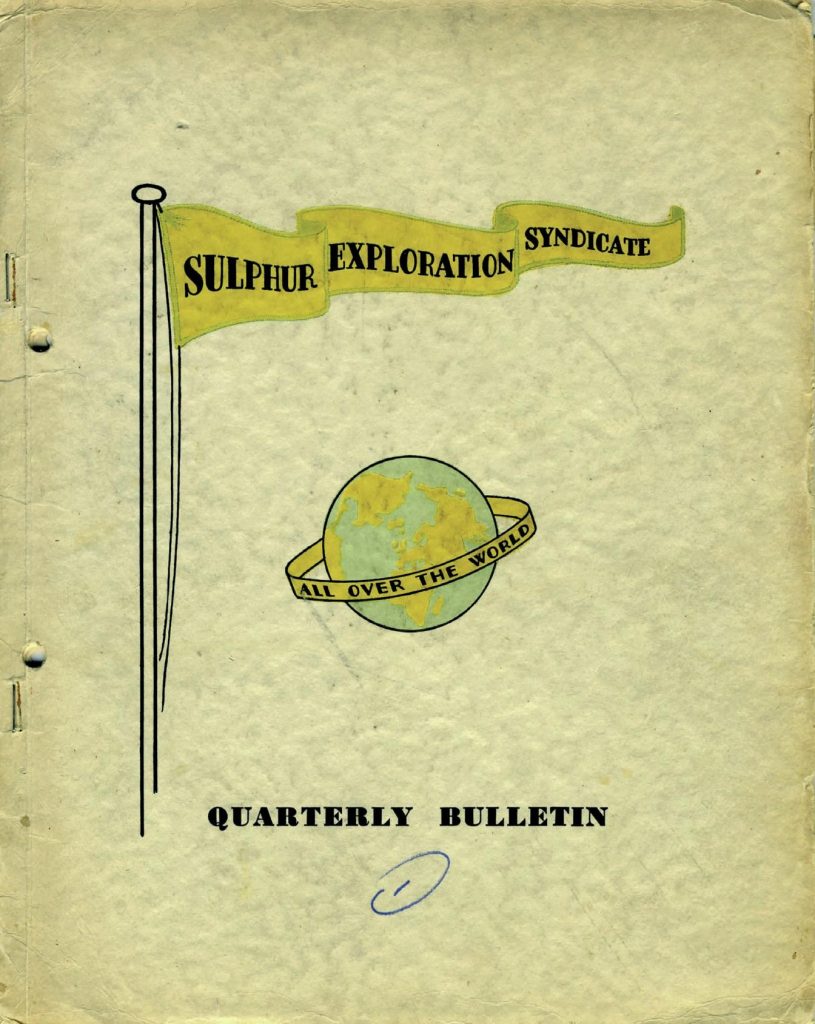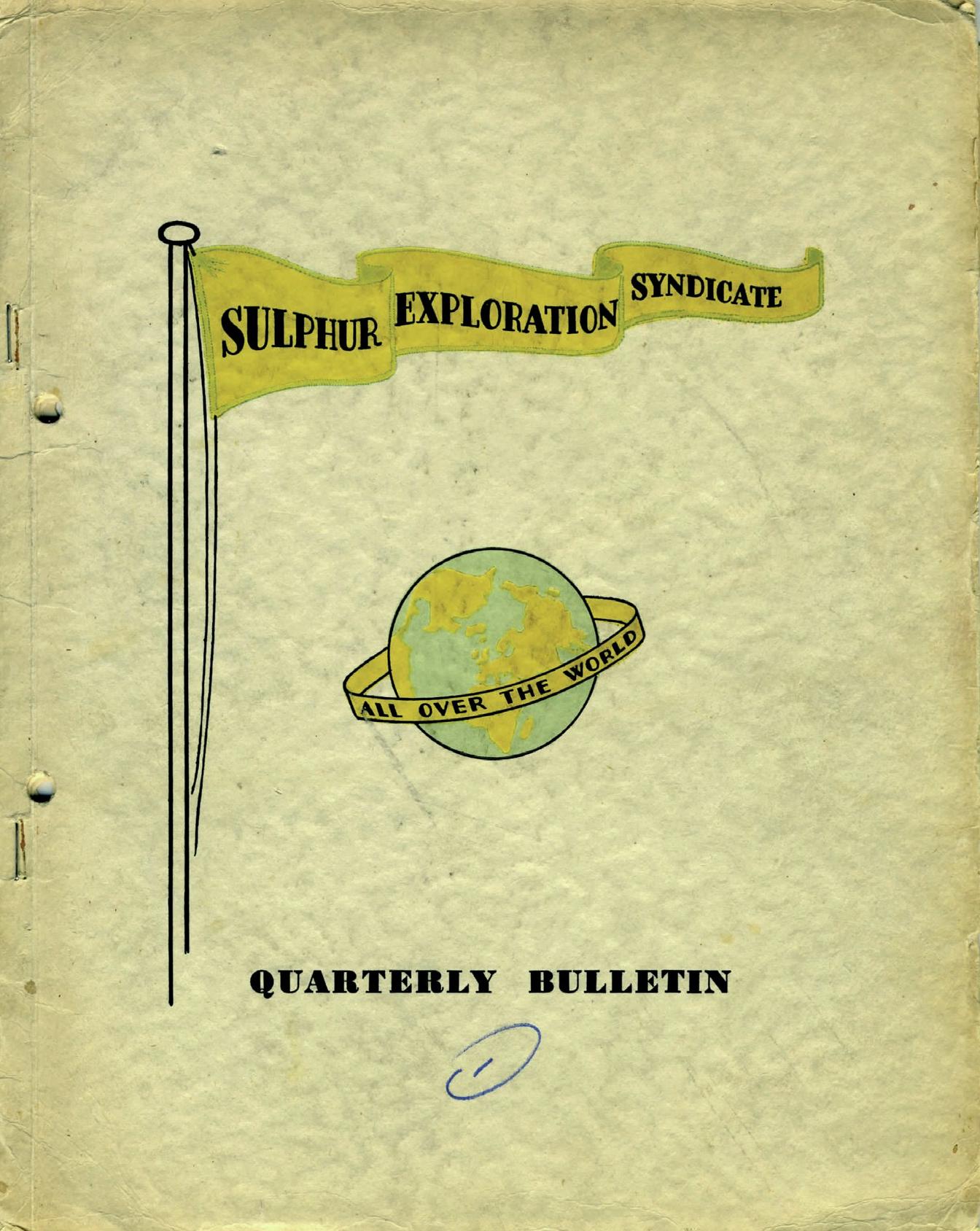Sulphur 407 Jul-Aug 2023

31 July 2023
Sulphur at 70

This June marks a milestone for this magazine; a platinum jubilee since the very first issue of the magazine was printed in 1953. It began life as the Quarterly Bulletin of the Sulphur Exploration Syndicate. The Syndicate was created in 1952, and was backed by nine major chemical producers, mainly in Britain and the US, who were concerned about dwindling world supplies of sulphur. Though some of these companies have vanished by the wayside over the years, including F.W. Berk and Co. Ltd, British Titan Products, Brotherton & Co., and Charles Tenant & Sons Ltd, others remain household names to this day, including Monsanto, Courtaulds (now part of Akzo-Nobel), and Dunlop (now owned by Goodyear), while Fisons’ fertilizer division was sold to Norsk Hydro in 1982 and today trades as part of Yara.
The syndicate in turn was a response to the publication in 1952 of the Paley Report by the United States Materials Policy Commission. This report estimated that the total available supplies of low-cost Frasch sulphur in the US were around 50-100 million tonnes in the ground, and that a further 250 million tonnes could potentially be sourced worldwide at an additional cost of 25-50% on prevailing market prices. Sulphur (in all forms) consumption in 1950 had been 4.8 million t/a in the United States and 6.7 million t/a elsewhere, though the ‘Soviet Bloc’, which at the time also included ‘Red’ China, was excluded from these figures. This figure was anticipated to rise to a global consumption of 25 million t/a by 1975. By that time, over 400 million tonnes of sulphur would have been consumed, and that was more than the 300350 million tonnes of elemental sulphur reserves that had already been identified. It seemed clear that new sources of sulphur were needed, and the Sulphur Exploration Syndicate aimed to find them.
The Syndicate, and the magazine, was the brainchild of John Lancaster. Czech by birth, Lancaster fled Nazi occupation of his country in 1938 and arrived in England, anglicising his name in the process. Like many exiles from eastern Europe he served with the British Army during the war, in his case specialising in Military Intelligence, with particular responsibility for identifying sources of key raw materials, of which sulphur was of course one. He and colleague Major-General Godfrey Wildman-Lushington CBE were among the founders of the Sulphur Exploration Syndicate, which by 1955 had become the British Sulphur Corporation. At the same time the Quarterly Bulletin had become the Journal of World Sulphur, and very shortly thereafter, simply Sulphur.
Industry evolution
The sulphur industry was a very different beast in 1953. Production was almost exclusively by Frasch mining, with the United States, the place where it was first used by Herman Frasch at what is now Sulphur, Louisiana, still by far the largest producer. In 1952 the US produced 5.5 million t/a of sulphur, or 88% of the sulphur output of what the Quarterly Bulletin somewhat quaintly calls the ‘Free World’. Outside of the US, only Italy, Norway and Japan produced more than 100,000 t/a, with Italy, once the world’s largest producer in the 19th century, still relying heavily on mined volcanic sulphur deposits from Sicily. The US was of course also the largest exporter, at 1.3 million t/a, with Canada and the UK the main destinations.
Of equal importance was ‘sulphur in other forms’, i.e. sulphur recovered from smelter operations, mainly in Europe, and sulphuric acid production from pyrite roasting. But in its survey of the sulphur industry in mid-1953, the Bulletin does note that the oil industry, a major consumer of sulphuric acid, was actually beginning to generate more sulphur than it consumed, by recovery from cracker off-gases, regeneration of spent sulphuric acid, and, especially in Canada, by treatment of sour natural gas. In the UK, sulphur recovery began at Shell’s Stan-low refinery in 1952, to the tune of 12,000 t/a, with a similar amount to come onstream in 1954 from Standard Oil’s Fawley refinery, and BP (then the Anglo-Iranian Oil Company) at Grangemouth. Recovered sulphur in the US reached 248,000 t/a in 1952, and the Bulletin comments that “legislation in connection with the sour gas exports to the United States and to eastern Canada is thought to be imminent. It is known that Texas Gulf Sulphur Corporation is actively interested in a large-scale recovery project of sulphur from sour gas.” It also comments that; “mention should be made of the vast deposits of bituminous sands in Northern Alberta. The Fuels Division of the Departments of Mines and Technical Surveys at Ottawa and other research stations have developed several different processes for the extraction of cleaned bitumen and for the recovery of sulphur from it.”
The sulphur industry was therefore clearly on the cusp of the seismic change that it would go through during the remainder of the 20th century, as sulphur from sour gas and refineries, particularly in Canada and the US, came to dominate world sulphur production. In the US, the Clean Air Act was passed in 1963, and it and its various amendments progressively restricted sulphur content of fuels. Frasch sulphur was still the dominant form until the 1980s, when the rapid expansion of sour gas processing and refinery recovery began to outstrip it. The last US Frasch mine closed in 2000, and today there is only one Frasch mine still operational, in Poland.
Pricing
Then, as now, the magazine covered sulphur markets and pricing, and the figures are instructive. In 1953, US sulphur prices were about $30/t f.o.b., but end users like Italy or Japan could pay $80-90/t c.fr. These prices are, so my inflation calculator tells me, equivalent to $340/t and $910-1,025/t respectively – think on that if you feel your sulphur is expensive! The move from Frasch mining to Claus recovery and the consequent scale up of the industry has brought prices down considerably in real terms, though perhaps not as much as it has for other commodities.
“The sulphur industry was on the cusp of the seismic change that it would go through during the remainder of the 20th century.”
The future
If the 1980s and 90s were the time of the triumph of the recovered sulphur industry in North America, then the period since then has been an equally notable internationalisation of the industry, with sour gas recovery spreading to China, the Middle East and Central Asia, and the Middle East and Asia’s rapidly growing oil refining industries taking over from the shrinking output of Europe and North America. Consumption has changed too, with the very rapid growth of China over the past three decades and its need for phosphate fertilizer, and increasing use of sulphuric acid to recover key minerals like copper, nickel, uranium and now even rare earth metals.
During that time, global elemental sulphur output has increased more than tenfold – it turns out that the Sulphur Exploration Syndicate needn’t have worried about a looming shortage of sulphur after all. And yet, as the world begins to decarbonise and use of fossil fuels plateaus and, eventually, declines, we are starting to hear similar concerns about how we will source sufficient sulphur in future. Plus ça change…






